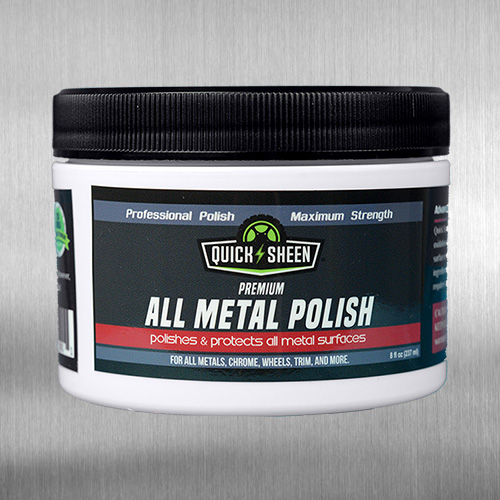Few things are as heartbreaking for a car enthusiast as spotting a fresh scratch on your vehicle’s paint job. Whether it’s the faint streak of a key, a light scratch, or the aftermath of gravel flicked up on the highway, scratches happen. But fear not—there are ways to restore your car’s beauty, and yes, polish can play a significant role in that process. Let’s break down what types of scratches can be tackled with Quick Sheen’s All Metal Polish and how to do it right.
To effectively tackle car scratches, it’s essential to know what you’re dealing with. Not all scratches are created equal—some can be easily removed, while others require extensive work.
Clear coat scratches are the most common and generally the least severe. The clear coat is the top layer of your car’s paint job, designed to protect the colored base coat beneath. Minor scuffs that only mar this layer, often referred to as light scratches, are often removable with the right tools and techniques.

When a scratch goes deeper than the clear coat and exposes the base coat (the layer that gives your car its color), the damage becomes more significant. These scratches can be harder to fix with polish alone and may require a more intensive repair process.
The worst kind—deeper scratches cut through the base coat and sometimes expose the metal panel. Fixing these will almost certainly require professional intervention.
So, can polish remove scratches? The answer is a resounding yes—but with some caveats. Polishing works by removing a thin layer of the clear coat, effectively leveling out the area around surface scratches so it blends in seamlessly with the rest of the paint. Before polishing, thoroughly clean your car using a car washer cleaner. Dirt or grime left on the surface can worsen scratches during polishing by acting as an abrasive. A spotless surface is crucial for successful scratch removal.
Polishes contain fine abrasive particles that wear down the top layer of paint. Quick Sheen’s All Metal Polish requires little to no buffing. Find out more about why Quick Sheen is the top polishing compound on the market!
Advancements in modern chemistry have allowed us to develop a non-abrasive, water-based formula that removes oxidation through a simple chemical reaction—without scratching the metal surface or stripping away its protective layer. This is what makes Quick Sheen so effective. You can stop spending hours scrubbing, buffing, and detailing. With the right tools, like Quick Sheen, you don’t need to. Our single application not only eliminates oxidation but also adds an additional protective layer that lasts up to six months, even under the harshest cold or hottest heat.

Now, let’s walk through the process of using Quick Sheen’s All Metal Polish to remove scratches:
Wash and Dry: Start by thoroughly washing and drying the scratched area to remove any surface debris. Use a car washer cleaner for a deep clean.
Apply Polish: Put a small amount of car polish on a microfiber cloth or applicator pad.
Even Application: Rub the polish evenly over the scratched area. Use gentle, circular motions or go back and forth across the scratch. Avoid pressing too hard, as this can cause more damage.
Buffing: Apply moderate pressure as you rub the polish in, making sure to work the area evenly.
Monitor Progress: Check frequently to see if the scratch is fading. If it’s barely visible, you’re on the right track. But don’t overdo it—too much polishing can damage the paint.
Elbow Grease: For stubborn scratches, a bit of extra effort might be necessary. Just be cautious not to over-polish.
Remove Excess Polish: Wipe away any excess polish with a clean microfiber cloth to reveal a smoother, scratch-free surface.
Apply Wax: Finish the job by applying a layer of wax. This step isn’t just about shine; it adds a protective coating to your car, helping to shield it from future scratches and damage.
Polishing can be a highly effective way to remove minor scratches and restore your car’s shine. By understanding the type of scratch you’re dealing with, using the right tools, and following proper techniques, you can tackle those pesky blemishes yourself. Remember, for deep scratches or significant damage, it’s best to seek professional help. Regular maintenance and a bit of elbow grease can go a long way in keeping your ride looking showroom-ready!
No, polishing is effective for minor and superficial scratches. Deep gashes often require more extensive repairs.
Regular maintenance is key. For most cars, polishing once or twice a year strikes a good balance between appearance and paint protection.
Choose a high-quality automotive polish suitable for your car’s paint type. Quick Sheen's All Metal Polish is non-abrasive and gets the job done!
Copyright ©2024 • Quick Sheen | All Rights Reserved. Sitemap
Website Development & Marketing by Arcane Marketing